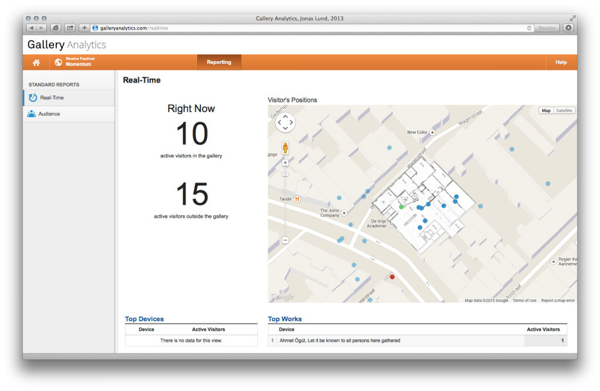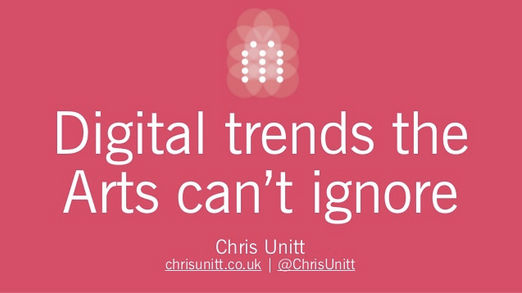a site specific installation by Swedish artist Jonas Lund, made especially for the Momentum exhibition as part of the Rewire festival.
By setting up a mesh wifi network and combining it with custom made software, Gallery Analytics is able to track every wifi enabled device moving around in the exhibition area in real time. Similar to how a shopping mall is tracking their visitors to determine how well a window display converts customers, Lund will be able to provide in depth analysis of the exhibition visitor’s movement in the space and from that distill how well the works in the exhibition performs.
The wifi mesh network is connected to an online, openly available, gallery analytics website where the tracking data and analytics can be accessed. This interface is also installed in the exhibition space, to enable the visitors to detect that they are being analyzed.
Arts/digital links
Bad times at the Sydney Opera House hackathon but with some constructive advice here too.
MoMA Seeks an Audience Beyond Its Walls is the title of a WSJ article about a blog. Only, by the way they talk about it, you’d think they’d just invented the Internet or something.
Not read this yet, but it’s on the list: Museum transformation in the digital age Museum transformation in the digital age
In this paper I will discuss Tate’s approach to the delivery of its digital strategy 2013-2015, which emphasises digital as a dimension of everything, drawing on my own work as the Digital Production Lead at Tate.
Speaking of Tate, they put the metadata for ‘around 70,000 artworks and 3,500 associated artists’ on github. Here are some links to what people have done with or said about this.
As part of a larger Arts Council England funded project [several councils and a museum] are working in partnership to explore how viral marketing might be used to raise the profile of museums in Hampshire.
Please, someone tell them.
DIGITALMEETSCULTURE is “intended as a portal for gathering information about the digital culture in the world, taking into account the different approaches that science, cultural heritage and arts have to the digital age”
Arts Council of Wales have announced their first funded projects for their Digital Research & Development programme.
Alyson Fielding has been having some Digital adventures in theatre:
We’re looking at how technology can create new experiences for audiences, specifically for one of The Other Way Works’ shows which is touring in 2014.
The Other Way Works also featured on Sync’s list of Ten more digital arts projects we love.
Other things that fall under this heading:
- Arup’s Museums in the Digital Age is another thing I’ll have to read at some point.
- Mobile and the arts: where to start? from Econsultancy is fine, but… I dunno. Nice to get an outside perspective but there’s a lot missed out and the stuff about apps feels a few years old now.
- Tate launches art weather forecast. Didn’t they do a series of weather-based Facebook posts?
- StageBitz makes online inventory, record keeping and production management tasks simpler through a centralised online platform
- Pharrell Williams – Happy – Wonder if anyone was inspired by the way the Get Lucky clips were looped up before the proper release of that song.
Other links
In the past couple of weeks there’s been quite a lot of kerfuffle about how touring artists try to make a living. Bryony Kimmings started it with You show me yours…. The result was a whole lot of blog posts (it was like being back in 2004). Artsadmin have compiled them.
Fiona Romeo’s Can an exhibition be a story? is great and well worth your time, with lots of thoughts and observations on how the stuff that makes up an exhibition is experienced.
This video about the building of a new NFL stadium was intriguing, especially for the line: “Most NFL stadiums can’t compete with the high definition experience fans now get watching football at home”. They’re designing a new stadium not just for ‘fans’ but ‘fans with smartphones who need to be coaxed from their TVs’. But then you read about the effort that goes into an NFL broadcast and maybe it becomes clearer.
Just quickly:
- MeasureCamp – Blackhat Analytics presentation from MeasureCamp. Now there’s a thing.
- The Nominet Trust 100 is a load of social innovations using digital technology.
- The Black Book by Jean Keller (Paperback) is a 740-page book printed margin to margin in black ink.
- I swear The Useless Web could’ve been a ‘curated’ digital art project.
What Screens Want by Frank Chimero is very good, even if I think the ‘we should all just make everything lovely’ sentiment is a utopian step too far from reality. And I don’t think the ‘grain of the screen’ stuff is quite right. Minor quibbles though – lots of goodness in that post.
Apps, services, etc
Finally…
IDIOTS is a charming little send-up of our relationships with our devices.


